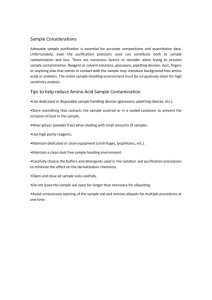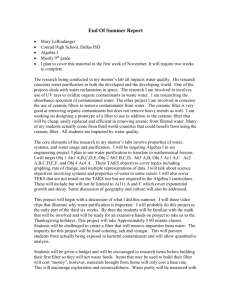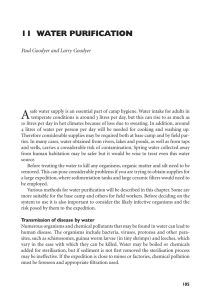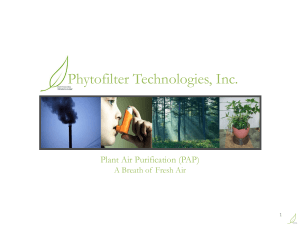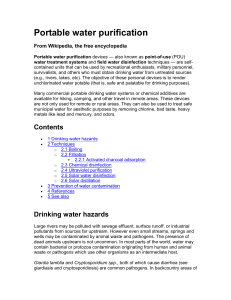At the beginning of every trip we have a safety talk in the initial
advertisement
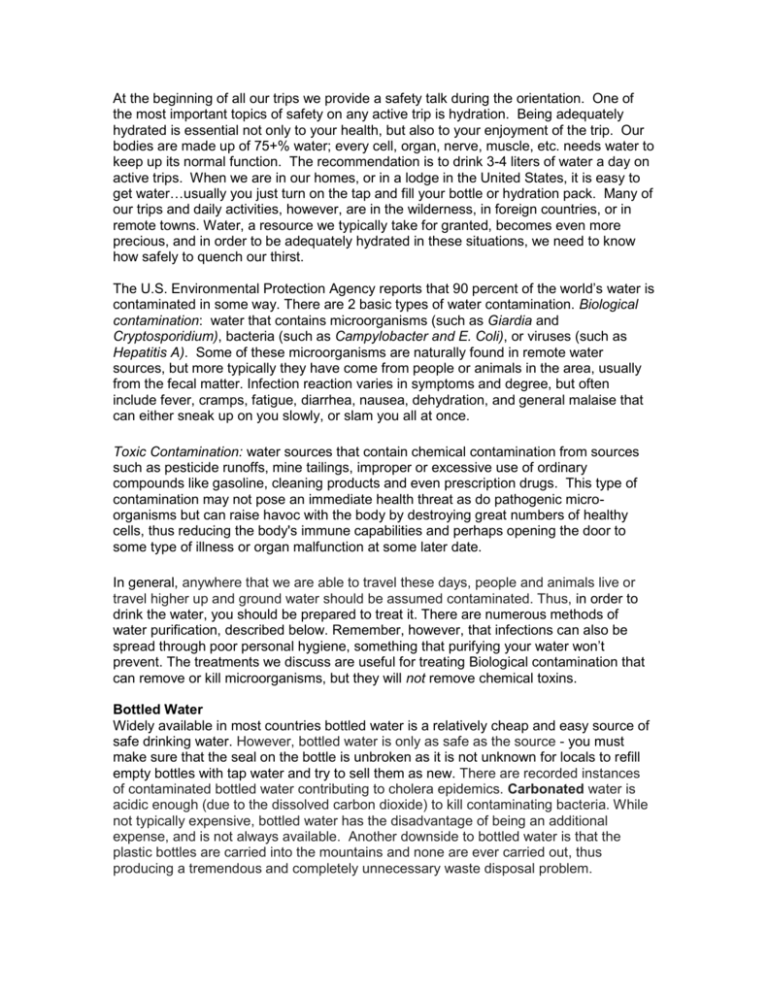
At the beginning of all our trips we provide a safety talk during the orientation. One of the most important topics of safety on any active trip is hydration. Being adequately hydrated is essential not only to your health, but also to your enjoyment of the trip. Our bodies are made up of 75+% water; every cell, organ, nerve, muscle, etc. needs water to keep up its normal function. The recommendation is to drink 3-4 liters of water a day on active trips. When we are in our homes, or in a lodge in the United States, it is easy to get water…usually you just turn on the tap and fill your bottle or hydration pack. Many of our trips and daily activities, however, are in the wilderness, in foreign countries, or in remote towns. Water, a resource we typically take for granted, becomes even more precious, and in order to be adequately hydrated in these situations, we need to know how safely to quench our thirst. The U.S. Environmental Protection Agency reports that 90 percent of the world’s water is contaminated in some way. There are 2 basic types of water contamination. Biological contamination: water that contains microorganisms (such as Giardia and Cryptosporidium), bacteria (such as Campylobacter and E. Coli), or viruses (such as Hepatitis A). Some of these microorganisms are naturally found in remote water sources, but more typically they have come from people or animals in the area, usually from the fecal matter. Infection reaction varies in symptoms and degree, but often include fever, cramps, fatigue, diarrhea, nausea, dehydration, and general malaise that can either sneak up on you slowly, or slam you all at once. Toxic Contamination: water sources that contain chemical contamination from sources such as pesticide runoffs, mine tailings, improper or excessive use of ordinary compounds like gasoline, cleaning products and even prescription drugs. This type of contamination may not pose an immediate health threat as do pathogenic microorganisms but can raise havoc with the body by destroying great numbers of healthy cells, thus reducing the body's immune capabilities and perhaps opening the door to some type of illness or organ malfunction at some later date. In general, anywhere that we are able to travel these days, people and animals live or travel higher up and ground water should be assumed contaminated. Thus, in order to drink the water, you should be prepared to treat it. There are numerous methods of water purification, described below. Remember, however, that infections can also be spread through poor personal hygiene, something that purifying your water won’t prevent. The treatments we discuss are useful for treating Biological contamination that can remove or kill microorganisms, but they will not remove chemical toxins. Bottled Water Widely available in most countries bottled water is a relatively cheap and easy source of safe drinking water. However, bottled water is only as safe as the source - you must make sure that the seal on the bottle is unbroken as it is not unknown for locals to refill empty bottles with tap water and try to sell them as new. There are recorded instances of contaminated bottled water contributing to cholera epidemics. Carbonated water is acidic enough (due to the dissolved carbon dioxide) to kill contaminating bacteria. While not typically expensive, bottled water has the disadvantage of being an additional expense, and is not always available. Another downside to bottled water is that the plastic bottles are carried into the mountains and none are ever carried out, thus producing a tremendous and completely unnecessary waste disposal problem. Boiling Boiling is the most certain way of killing all microorganisms. The process of heating water to a boil (212 F or 100 C) makes it hot enough long enough to disinfect it, even at elevations as high as Everest Base Camp. You only need to boil the water for a minute, even at high altitude. The disadvantage of boiling water is that it requires time and equipment to heat the water. Chemical Purification Adding chemicals to the drinking water kills bacteria, microorganisms and viruses. This type of purification involves adding a few drops or tablets to the water, shaking it and then letting it sit for a certain period of time (usually ½ hour). There are 2 chemicals typically used for chemical purification: Iodine and Chlorine. Iodine is available in many forms - in either tablets or crystals form, or as a tincture - which makes it convenient to find, but can be confusing in knowing ratios to use. Iodine has been shown to be very effective in inactivating Giardia, but does not always work on killing Cryptosperidium. It is also a very lightweight option, and can double as a necessary addition to your 1st Aid Kit. Be aware that some people are allergic to iodine and cannot use it as a form of water purification. Persons with thyroid problems or on lithium, women over fifty, and pregnant women should consult their physician prior to using iodine for purification. Also, some people who are allergic to shellfish are allergic to iodine. Chlorine can be used for persons with iodine allergies or restrictions. Chlorine is probably best used in an emergency situation. It is typically used in larger quantities than iodine in order to purify the water, which often results in an objectionable taste – even worse than the iodine taste. Chlorine is not always effective against viruses. And it can be toxic in the event of an overdose, so you need to be careful when diluting the solution. Another disadvantage to chemical purification is that the killing effectiveness is dependant on concentration of the chemical, temperature of the water, and contact time. Cloudy water often requires higher concentrations of chemical to disinfect. The colder the water, the less effective the chemical is as a purifying agent, so the water needs to sit longer after treatment before drinking. Also, chemical purification often adds a less favorable flavor to the water. Be aware that if you use flavor crystals (i.e. Lemonade or Powerade mix), this should be added after the recommended contact time for purification but using them definitely helps neutralize the taste. Additionally, be advised that many of the tablets have an expiration date and become ineffective after that point. Once the bottle has been opened, the tablets usually must be used within a certain period. When in doubt, buy a new bottle. Iodine is also light sensitive and must always be stored in a dark bottle. For ease and effectiveness, chemical treatment is often the preferred method of treatment for traveling in remote countries, such as Nepal or India, though sometimes pre-filtering might be reasonable before treating it chemically. Filtration A water filter pumps water through a microscopic filter that is rated for a certain-size organism. There are a number of devices on the market that filter out microorganisms. The standard size rating is the micron (the period at the end of this sentence is about 600 microns). Depending on the micron rating of the filter, smaller organisms (like viruses) can pass through. Be cautious when selecting a filter. You should know what potential organisms you need to treat for. You don’t want to go to an area where a virus like hepatitis A is present in the water (a problem in some developing countries) with a filter that will handle only a larger organism like Giardia. There is a difference between a water filter and a water purifier. Filters do not filter out viruses, but there are water purifiers, like the PUR Scout, that pass the water through both a filter and an iodine compound that kills any smaller organisms that have passed through the filter. These purifiers kill all microorganisms down to 0.004 microns; however, even filters with purifiers added, have been shown to provide incomplete disinfection of contaminated water. Also these filters with purifiers should not be used by people who are allergic to iodine. Filters have the advantage of providing immediate access to drinking water without adding an unpleasant taste. However, they suffer from several disadvantages: micro cracks or eroded channels within the filter may allow passage of unfiltered water and cause contamination; care needs to be taken with the intake and out take ends, keeping them separate to avoid contamination. Water filters also need to be cleaned and filters replaced, depending on usage. In addition, they can expensive and bulky.
